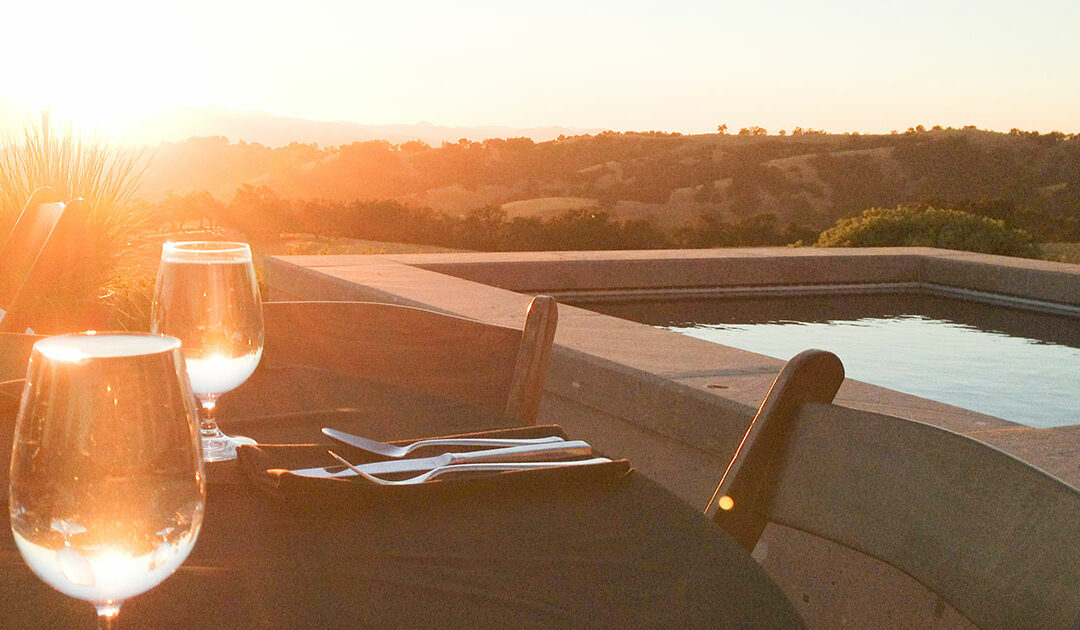
Mar 1, 2023
The Perfect Outdoor Party Space
Written by Tyler Ellison, Designer
Originally published in Living Lavishly
We know how much the venue sets the vibe. On the California Central Coast, the outdoors are a vibe. Mild evenings allow for gatherings almost year-round, so outdoor spaces become parts of the home—extensions of the kitchen, the dining room, the living room, the party. Properly envisioned outdoor spaces transform a bland lot into vibrant, flexible, and personal additions to the interior living areas. Here are some considerations for creating the perfect outdoor party space:
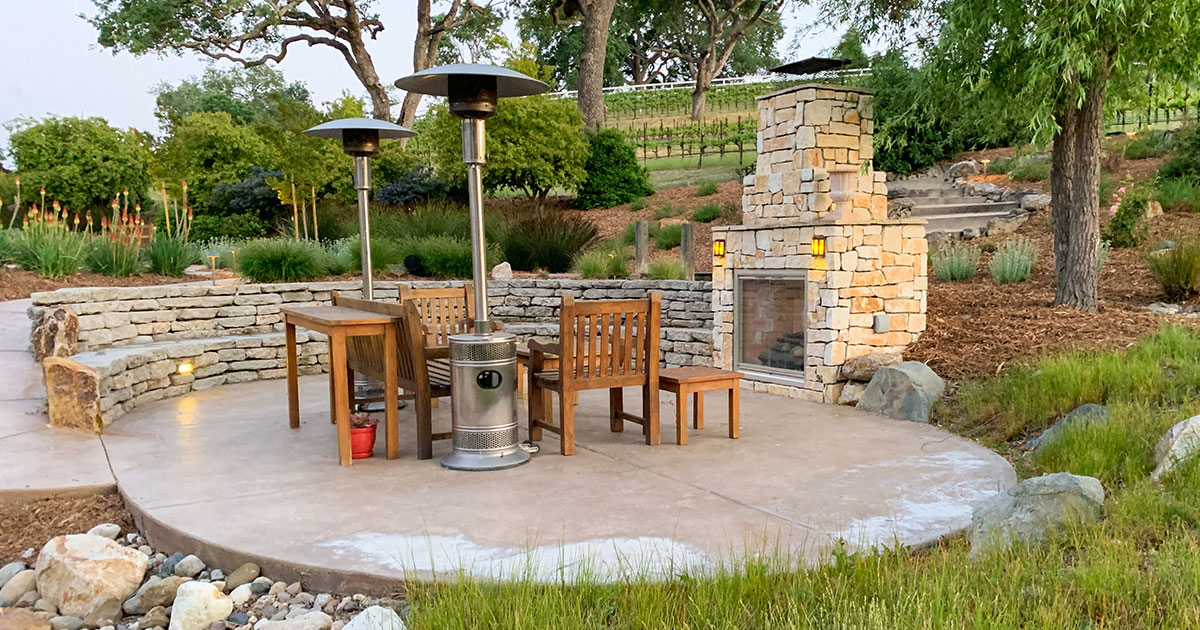
Embrace a Particular Design Character
A grove of trees, a feature wall, a boulder outcrop, or interior architectural styling might all imbue landscape character—conversely, a mishmash of incoherent features and materials is the easiest way to disjoint a garden. Attention to character results in the inclusion of similar materials, complementary colors, and pleasing combinations of texture. Perhaps a tile accent inside the house is repeated in a kitchen backsplash, or a modern architectural design mirrored with segmented concrete or clean large-format pavers. A thoughtful geometry of layout, attention to edges, and repetition of plant selections also work together to establish a cohesive character. During design it is helpful to collect imagery of specific materials and arrange them in palettes to ensure that selections are complementary and attractive.
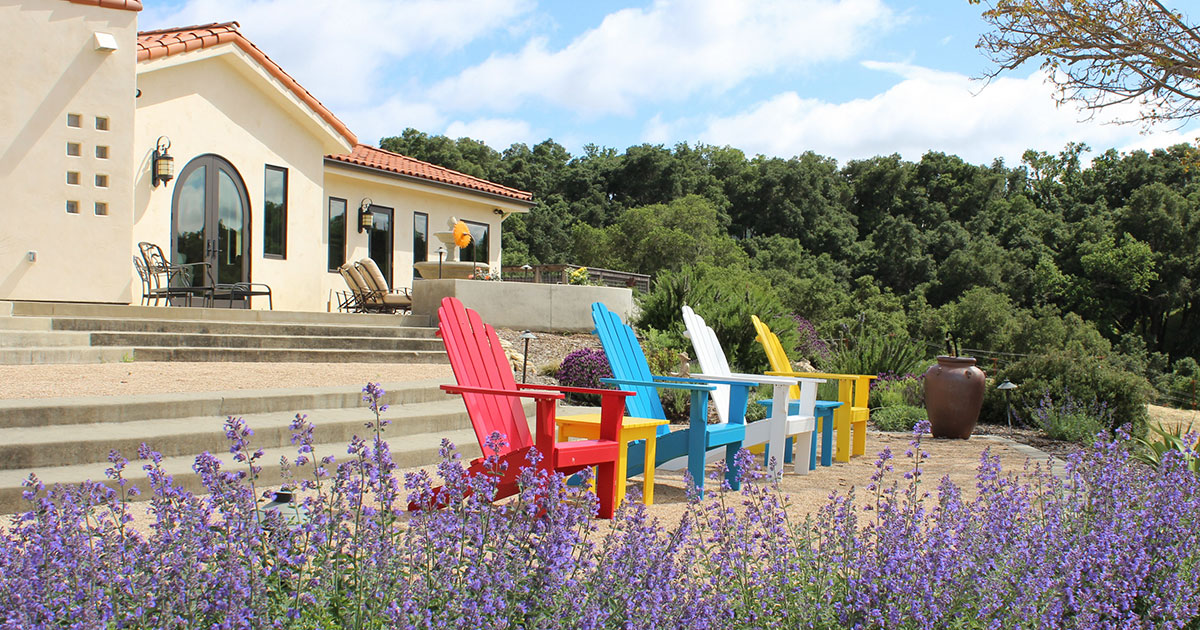
Determine Key Amenities for Your Type of Party
A patio dining space often provides the foundational element. Food and drink are the fuel for good times, so having dedicated locations for sitting while eating, standing while munching, even lounging while browsing gives opportunities for a diversity of guests and party sizes. Additionally, a buffet location adjacent to cooking zones allows for flexibility during food preparation and service. In the planning stage, it is helpful to create a list of desired uses and features. Some of amenities worth considering on the Central Coast include:
- Cooking – Gas BBQ, Griddle, Stove, Smoker, Wood Burning Oven, Ceramic Charcoal Grill
- Kitchen Elements – Sink, Counterspace, Trash Receptacle, Island, Refrigerator, Cooler, Warming Drawer, Cabinet, Water Heater, Ice Maker, Beverage Tap, Storage Drawer, Shelving
- Seating & Eating – Table & Chairs, Bistro Set, Bench, Bar Seating, Lounger, Seat Wall, Boulder Slab, Swing, Hammock, Patio, Deck, Nook, Overlook
- Activity & Play – Pool, Hot Tub, Plunge Pool, Play Structure, Hard Court, Turf, Bocce Court, Open Game Space, Sand Box, Ping Pong Table, Horseshoe Pit
- Comfort & Protection – Pergola, Gazebo, Heater, Fireplace, Wind Screen, Shade Sail, Umbrella, Shade Tree
- Warmth & Atmosphere – Firepit, Fire Feature, Fountain, Waterfall, Pond, Boulder Outcrop, Sculpture, Dry Creek, Wall, Gate, Arch, Pillars, Trees & Planting
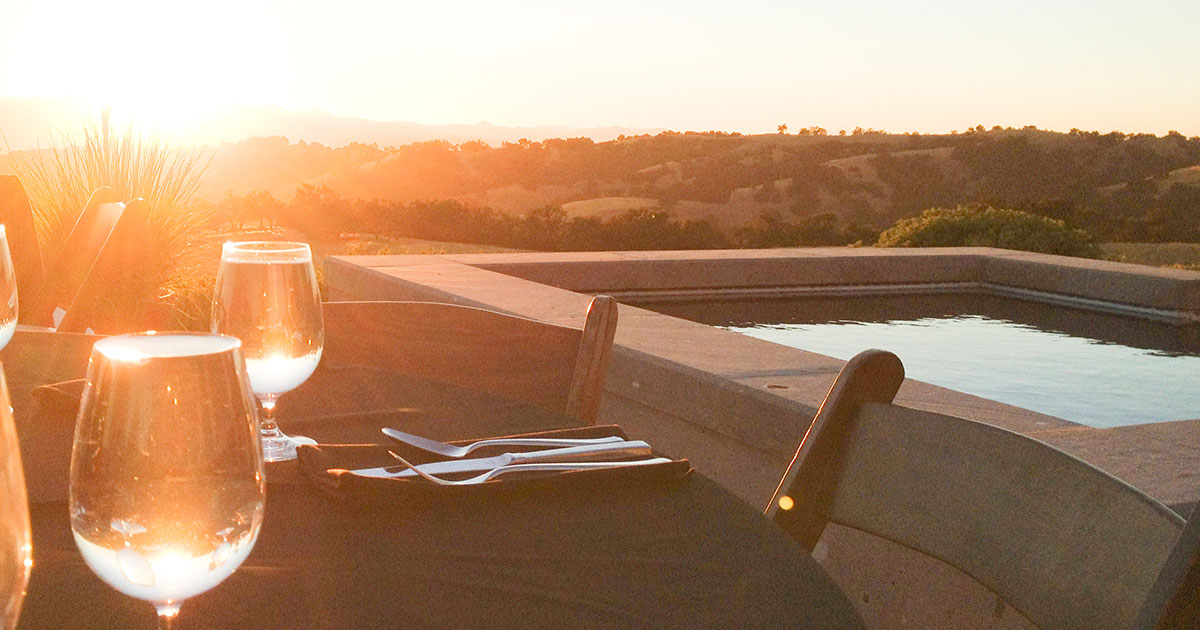
Explore the Best Location for Your Party Spot
In many instances, existing features will guide the answer to this question. A sweeping view of the Paso Robles hills or a mature Atascadero oak tree might perfectly frame a central party space. Flow between doors, gates, and seating areas should be considered, as well as proximity to the kitchen. A broad primary access path with secondary collectors prevents chokepoints during a busy party. Sun and shade patterns, as well as wind and other climatic features will suggest ideal zones for human enjoyment; a blustery wind in Morro Bay suggests a more sheltered party pad. Cloudy Los Osos might suggest a comfortable boulder-studded fire circle. Finally, planting often provides the smooth transition from hardscape into the larger landscape, playing a vital role in defining and elevating a space.
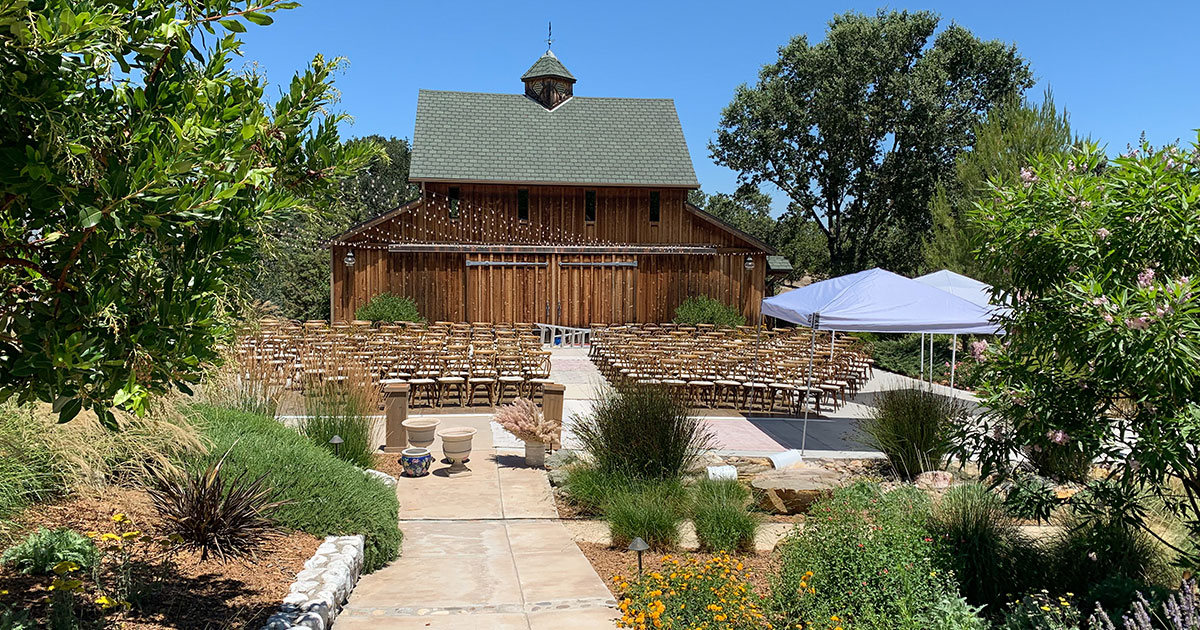
Design for Personalized Flexibility
You want to ensure that your landscape investment allows for all the various parties that you might throw. How can the space morph for different guest lists, different activities, even different seasons? A lawn can offer play for kids, cornhole for adults, or a dining extension for the big celebration. On a sloping site, a low perimeter seat wall might maximize the potential of a patio nook. A central elevated tree planter could provide fast shade, definition of space, and a place to sit. One furnishing can also provide multiple uses on different days: fire pits with hard covers can double as coffee tables or benches when the flame is off.
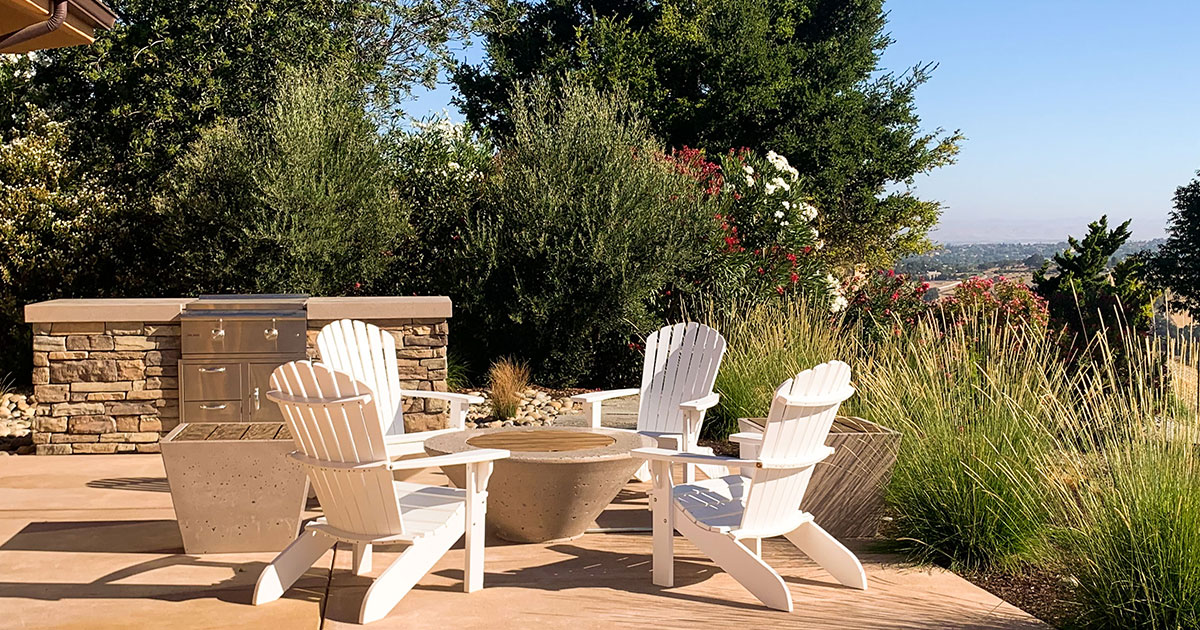
Furnish With Durable and Functional Pieces
Remember, you aren’t setting up your space just for the Instagram photos (although that may be a factor). Get tables, chairs, stools, and barbecues that will stand up in our environment—lots of sun, maybe fog or frost and the occasional rain. Near the beach? Consider the effect of salt spray. Up in scorching North County? Plan for some sort of shade. Certain materials and finishes offer greater protection than others. Concrete, stone, and metal are often the most rugged outside in the elements. Pots, pillows, and plant material can provide easy splashes of color in combination with other earthier features.

Install Lighting for Function and Safety
Lighting is the hidden gem of an outdoor party space. Since most parties happen later in the day, a beautifully illuminated garden turns a spooky yard into a welcoming room. There are many ways to light a space, and a well-designed lighting plan makes use of multiple types of fixtures. Up lights pointed along the trunks of trees can help define the boundary of a space. Integrated hardscape lights increase safety in stairways and definition along walls and fences. Overhead lights can provide an even glow across patio spaces. String “bistro” lights can provide low but consistent illumination over a large dining space.
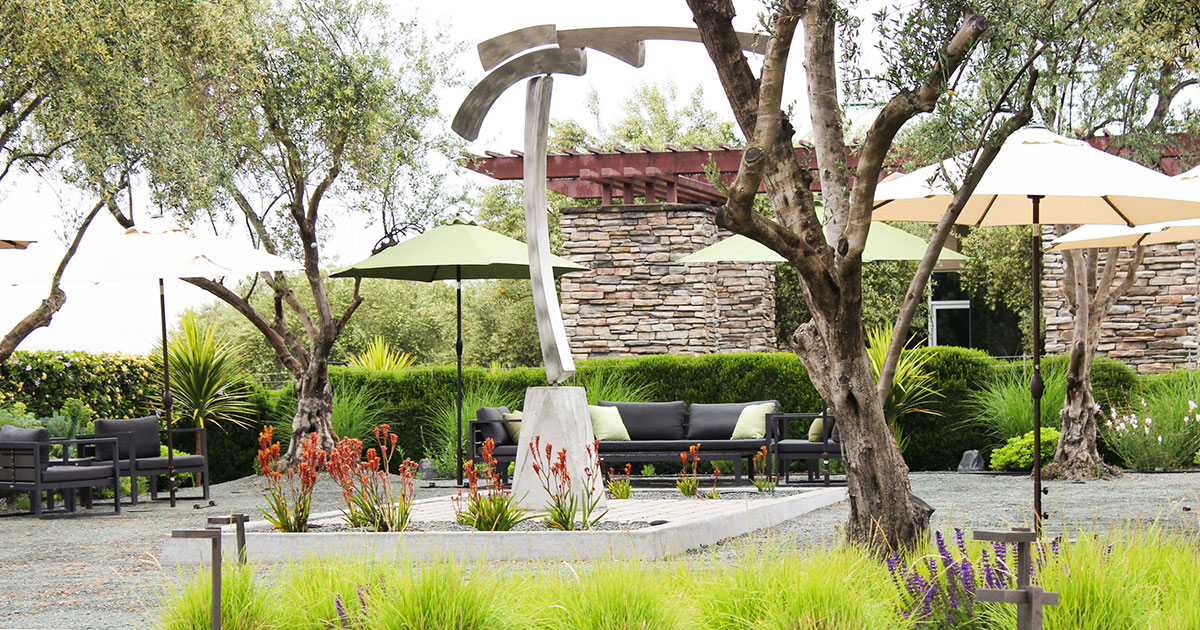
Outdoor spaces are designed, so an exploratory process ensures that any outdoor space is cohesive and fully resolved. Some homeowners begin with a full vision, and that’s great! If you don’t quite know what you’re looking for, that’s no problem at all. It simply means taking the time to consider what locations, features, character, furnishings, and elements will work best for the party space you want to have. For complex projects, a professional landscape designer will guide the transformation of inspired ideas into buildable plans on paper. At the same time, parties are all about people, so gather food and friends, make some space outside, and you’ll have a great party!
For more information and help with your landscape project, please visit madronelandscape.com.
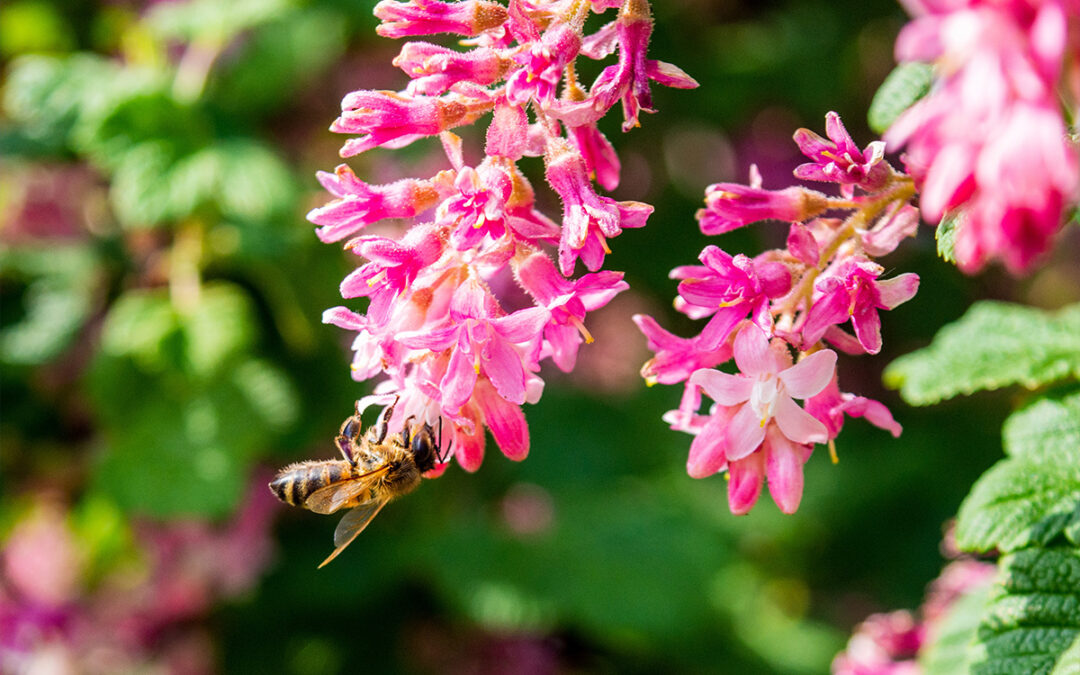
Jan 19, 2023
Eight Winter Bloomers for the California Central Coast
During the colder months on the California Central Coast, many of our plants fall back and go dormant. Throughout the region, from inland San Luis Obispo to coastal Morro Bay and north county’s Paso Robles, central coasters love year-long landscapes. With so many beautiful bloomers that thrive in our area, we can count on flourishing flowers to take the stage during any given season.
Here are eight of our winter favorites.
Aloe Striata
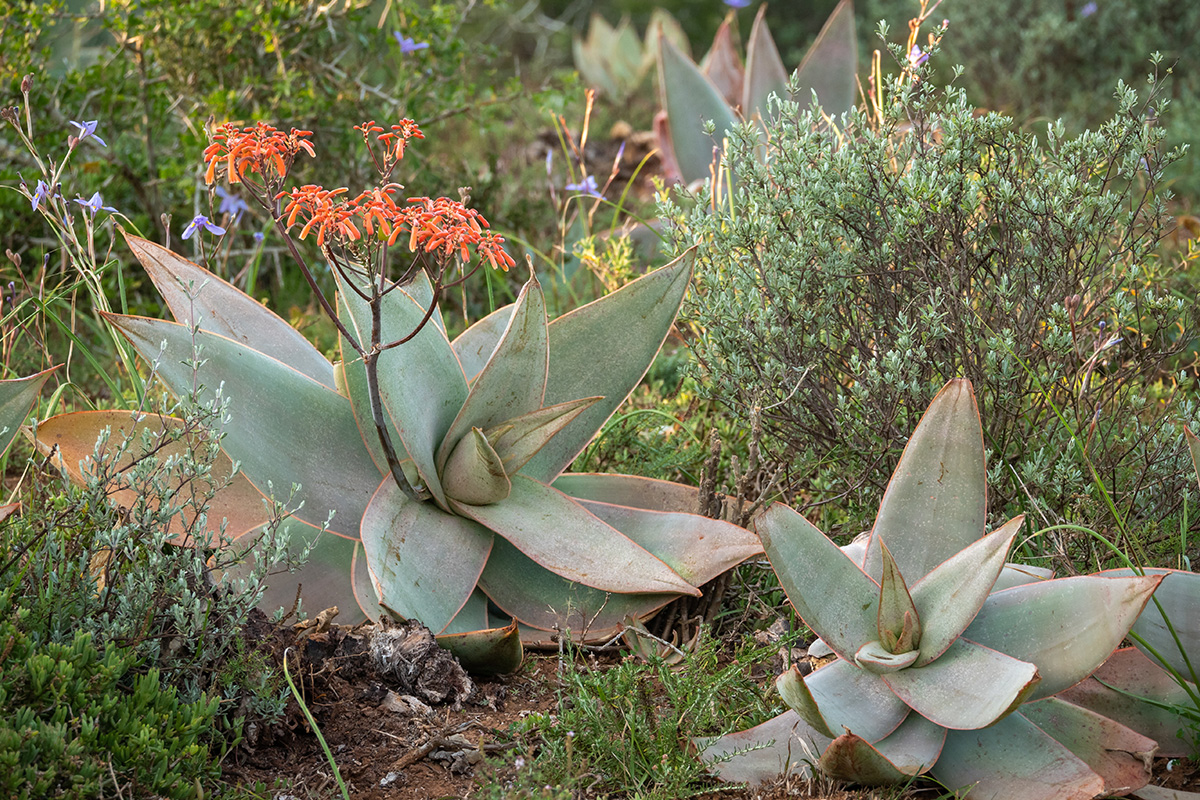
Aloe striata, or Coral Aloe, is memorable for its tall floral stalks the color range of a citrus sunset, but its leaves take the cake. Elegant and pale, their reddened edges lend a delicate blush year-round, even as it blooms in the winter.
Arctostaphylos
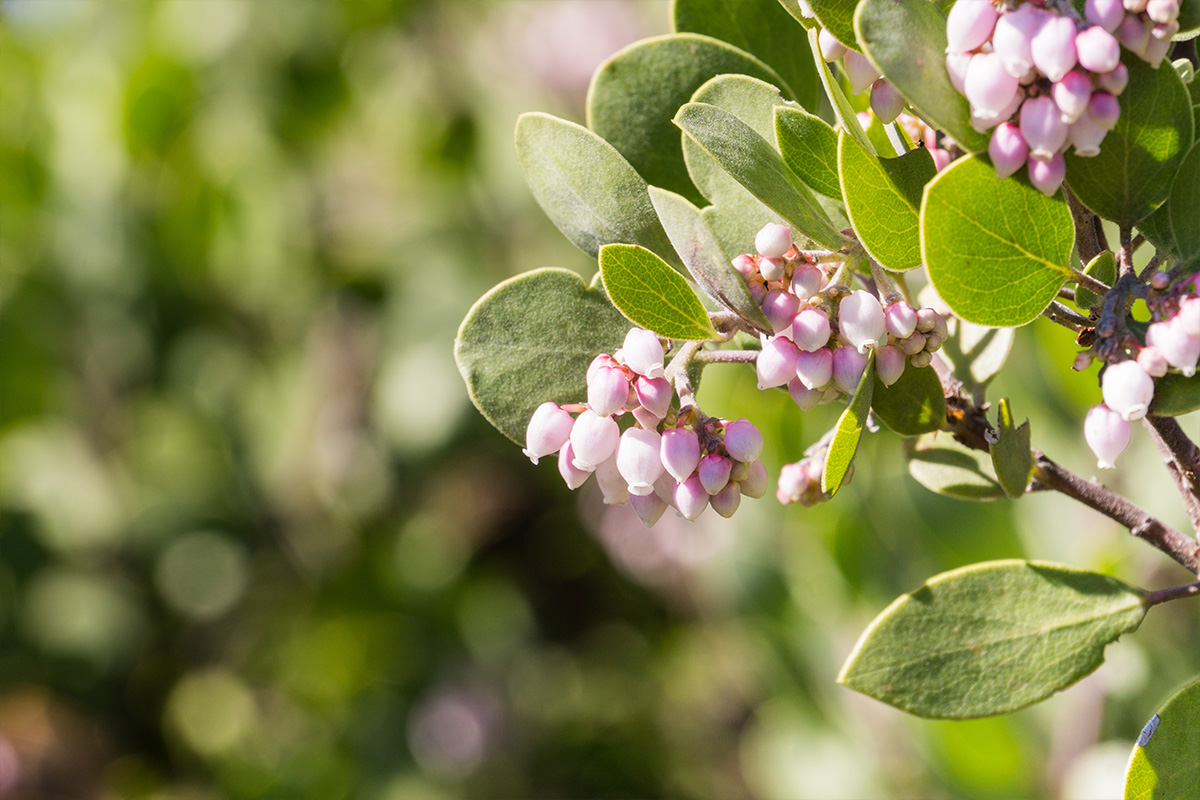
Drought-tolerant and robust year-round, these Manzanitas shrubs are popular for their handsome, red-toned bark and bunches of round, gentle flowers.
Erica Canaliculata
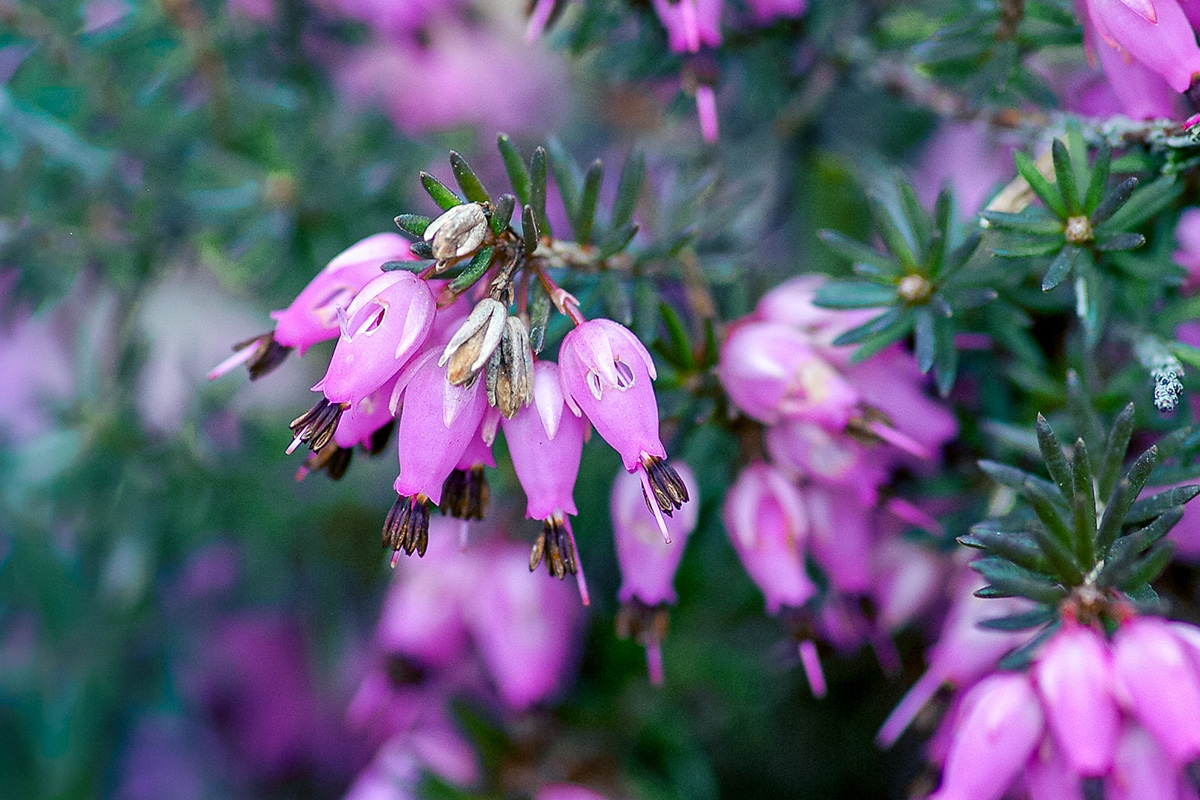
This showering splash of flowers is commonly known as channeled heath or hairy gray heather. Its bell-shaped flowers bloom in a cloud of pink to purple, lending waves of colorful body to every landscape it flourishes in.
Agave Attenuata
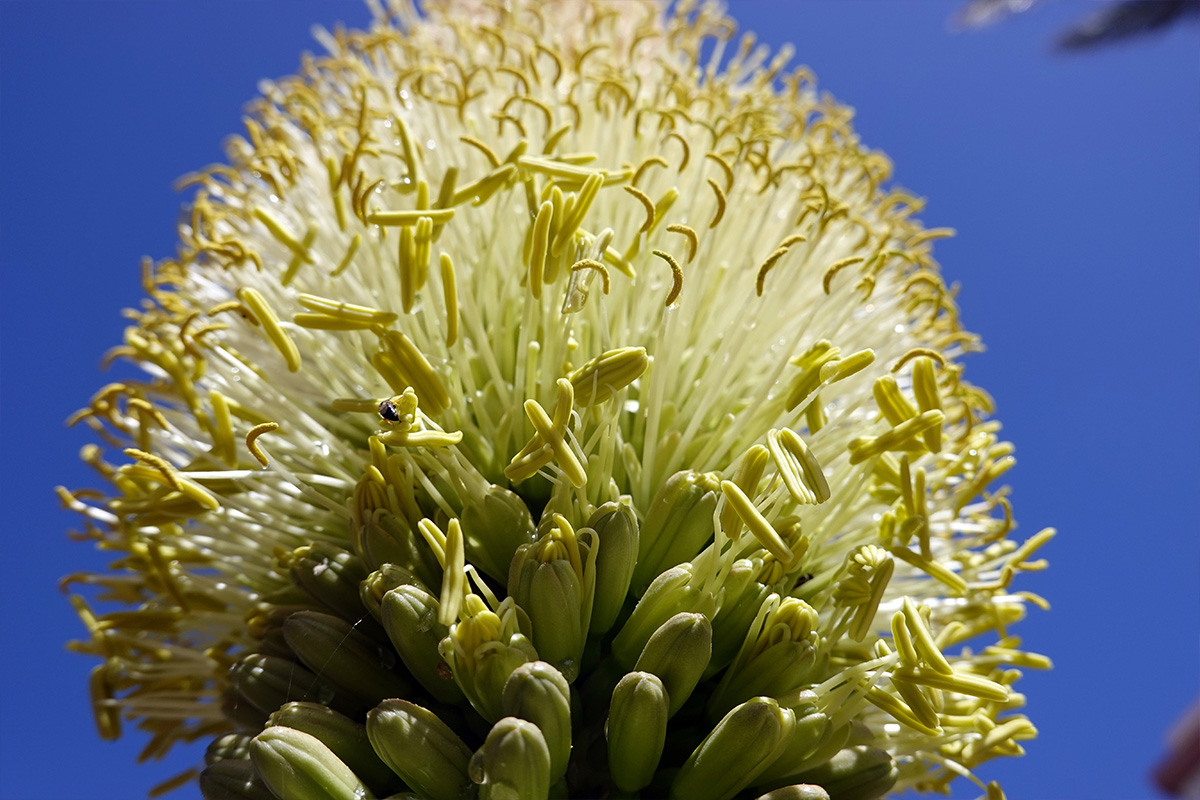
While the Foxtail Agave is typically known for its year-round architectural form and drought-tolerance, mature specimens will put out massive flower spikes once in their lifetime. Vibrant green, cool blue, and beautiful variegated cultivars are available, and will spread from basal shoots, eventually filling in a sizeable area.
Viburnum Tinus
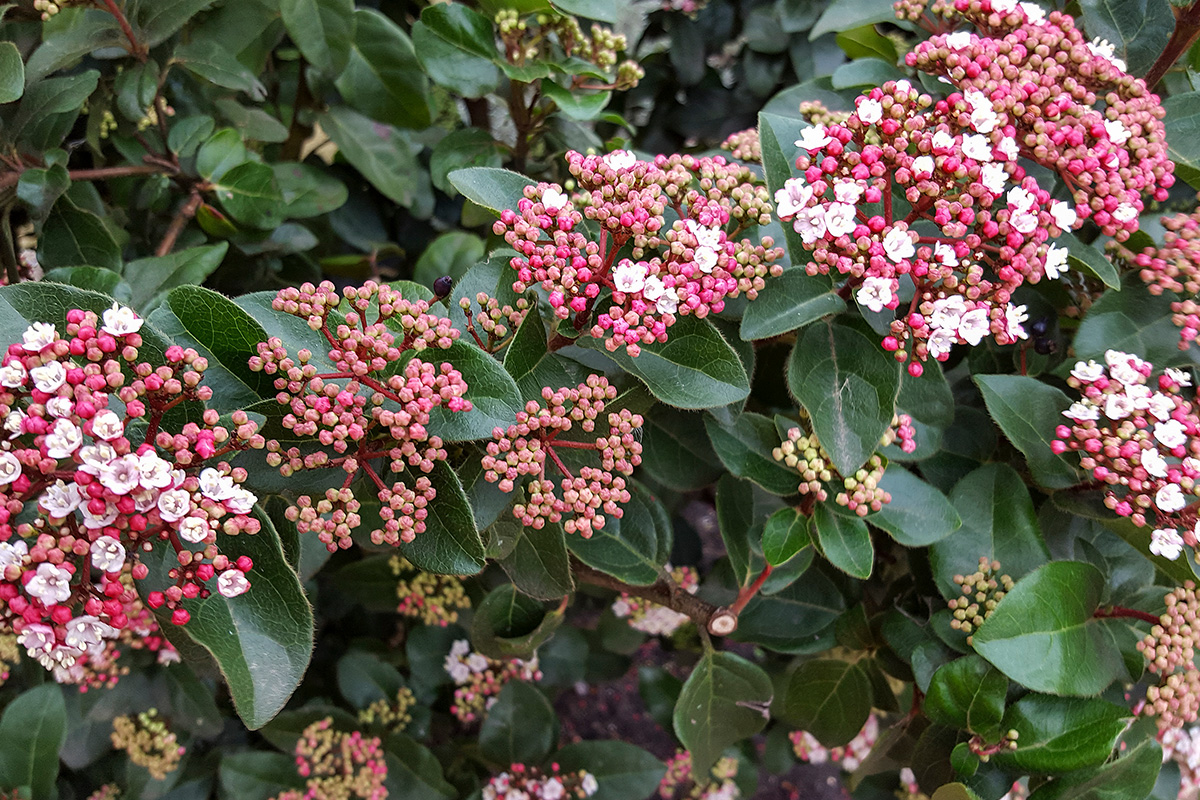
Another shrub bursting with fragrant and elegant blooms, the Viburnum tinus not only blossoms in the winter but provides a burst of metallic blue from its berries as well. It is well beloved by butterflies, bees, and clients alike..
Aloe Camperi
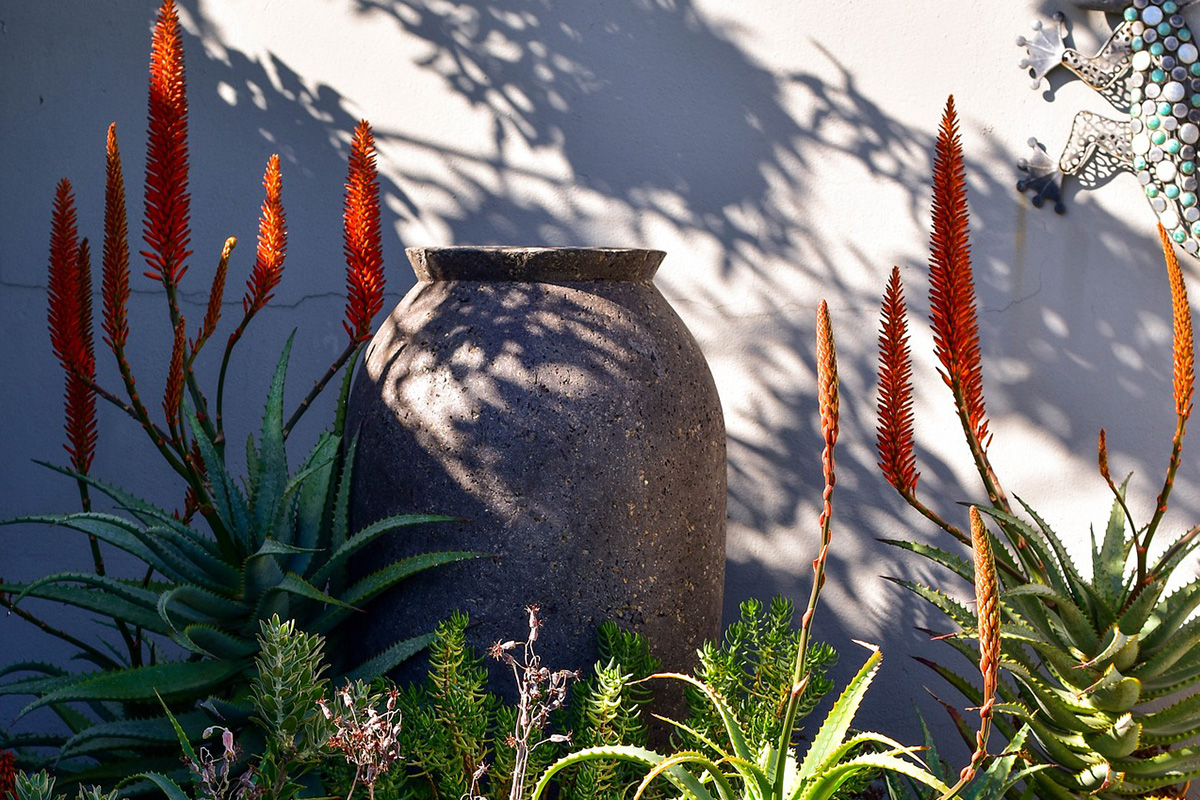
One of the few aloes with verdant green leaves, Aloe camperi or Popcorn Aloe, is a mid-rise plant with beautiful apricot flowers and a spindly, dramatic shape.
Grevillea ‘Moonlight’
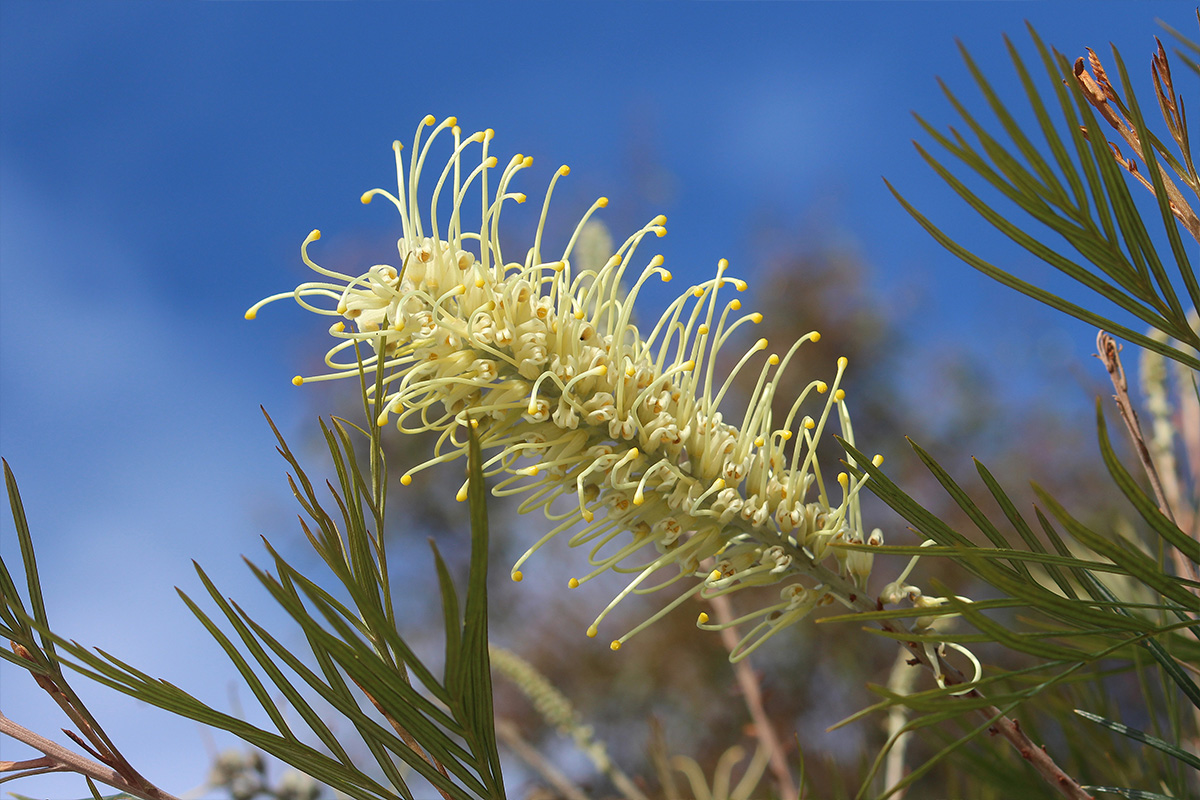
Large, fast-growing, and with lovely flowers reminiscent of loose embroidery, Grevillea ‘Moonlight’ is a bushy evergreen that brings its luminous ivory to your winter landscape.
Ribes ‘Spring Showers’
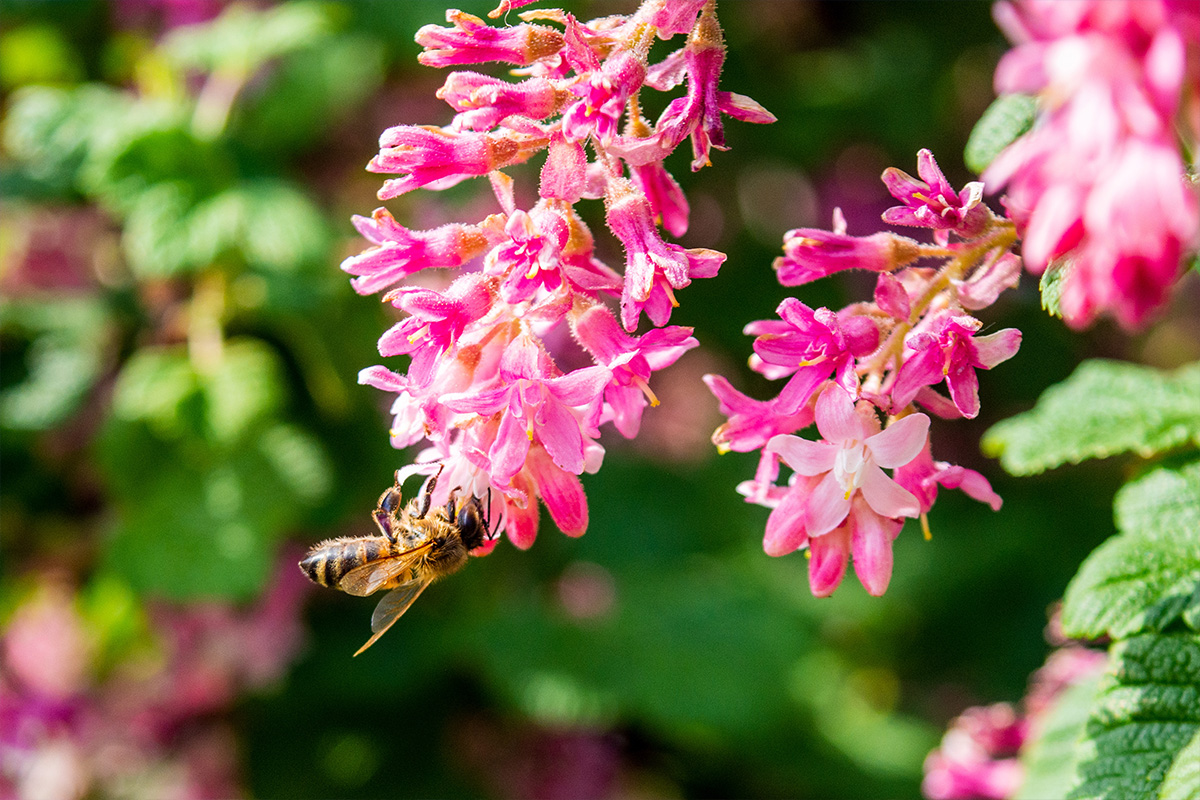
The pendulous pink flowers of this dainty plant come alive in winter, a vibrant display that can almost cover the foliage.
Looking for a landscape with plants that bloom in the winter? Talk to our landscape designers for a design tailored to your specific climate. Some of the species in this list are better suited for milder coastal climates, while others are bullet-proof even in frosty north county. Contact our landscape designers at [email protected] or (805) 466-6263.
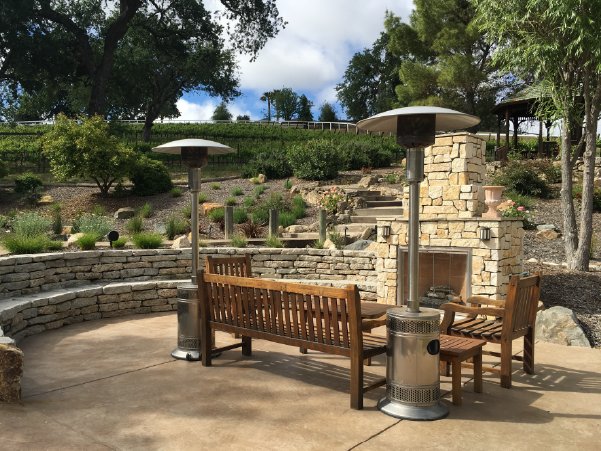
Dec 1, 2022
Transforming a landscape can be overwhelming—there are so many places to find inspiration, and there are drastically different styles to consider. It can be helpful to work with a professional—landscape designers are trained to see the big picture and identify opportunities that elude most homeowners.
Maximize Your Residential Landscape
Written by Daniel Mazawa, General Manager
Originally published in Living Lavishly
Here are a few steps homeowners can take to understand the design process and get a grasp of what they want from their landscape:
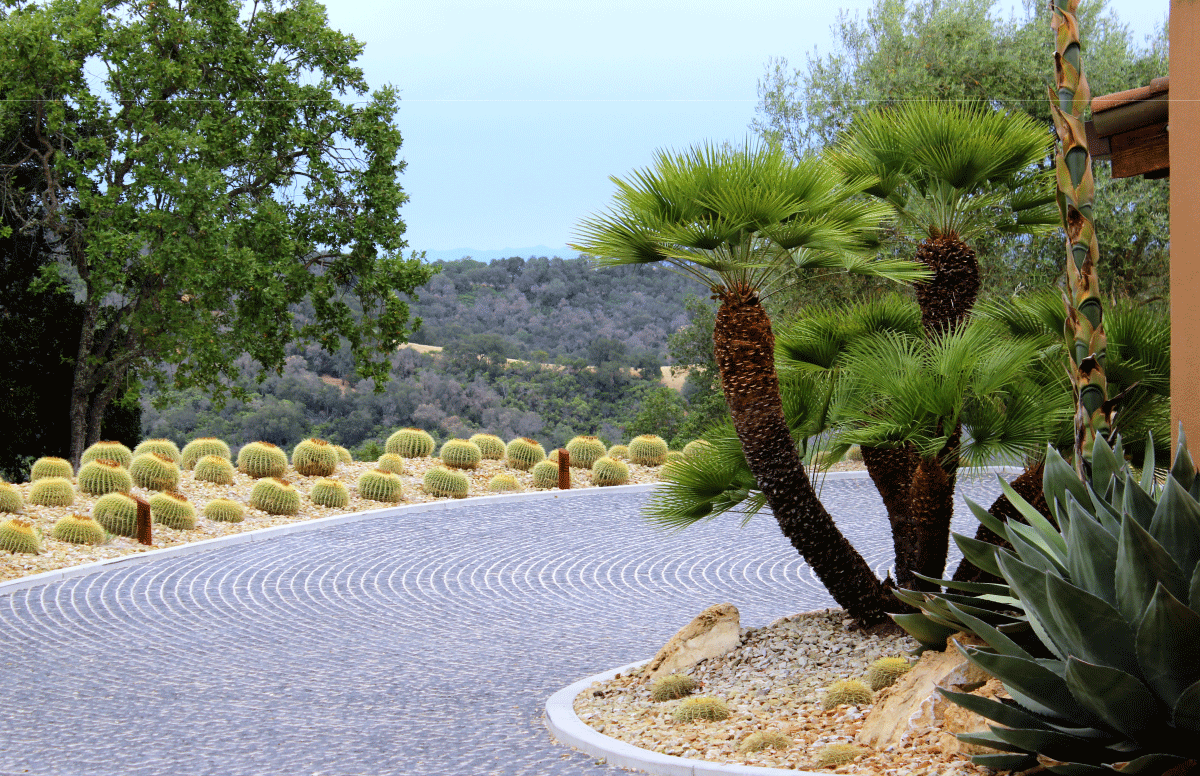
Analyze the Site
On the Central Coast, there are several different natural backdrops that most homes enjoy. Whether it is a distant view of rolling oak woodlands or a beachfront bluff experience, it is important to understand the setting of a place as influenced by the natural world. Take stock of existing trees or plants on site as well as sun and shade.
The architecture of the home and the neighborhood aesthetic may set the tone for the landscape design style. Consider the experience of driving up to the house and walking around the yard. A guest arriving at the home should know right where the front door is and where to park. The movement around the landscape should be functional and beautiful. Where are the areas of interest? What is the flow and the circulation? Identify the opportunities and constraints in a setting before figuring out what to do.
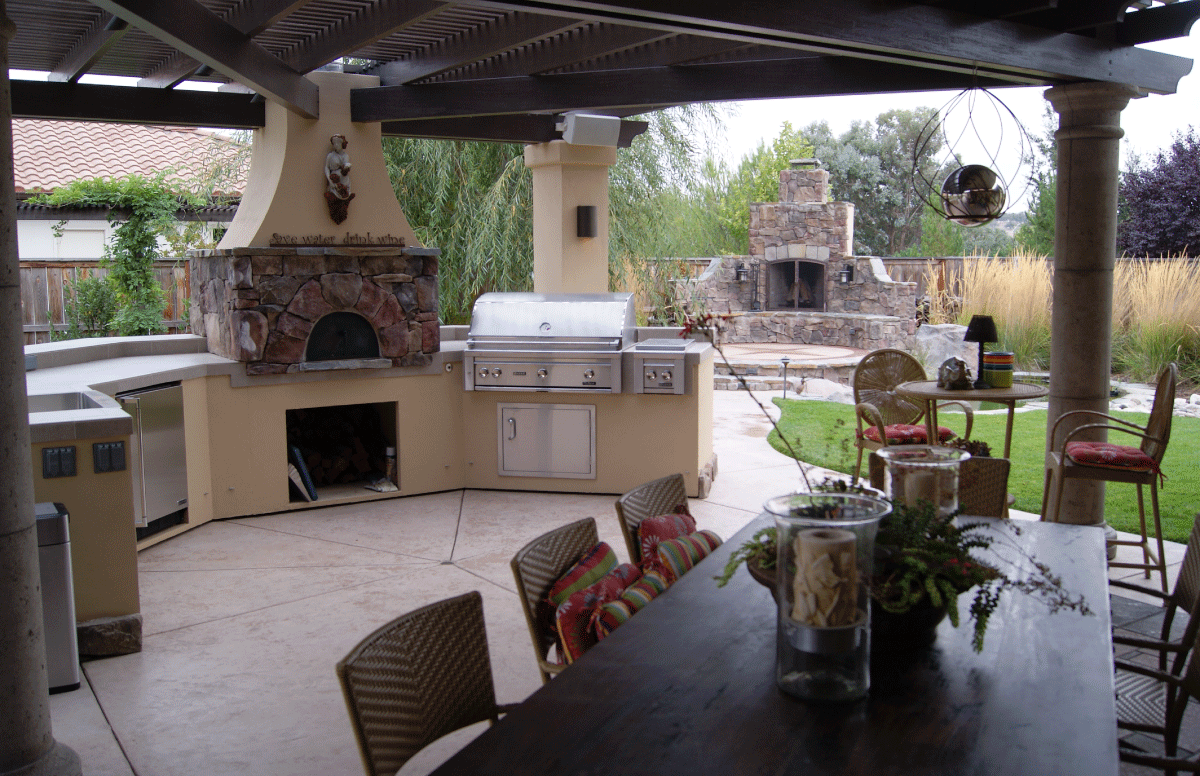
Establish the Functions
It is easy for someone who owns a home to identify what they want, but it can be a little more difficult to define what they need. Everything takes up space, so prioritizing functions is extremely important. Figure out how much usable space is needed for parking, outdoor entertaining, open utility areas, connecting pathways, and any other high-frequency functions. Pools, hot tubs, sport courts, outdoor kitchens, vegetable gardens, and other secondary functions can be fun additions to fold in.
Consider the best locations for all functions as far as convenience, sun exposure, views, and feel. For example, both an outdoor kitchen and a vegetable garden are convenient near an indoor kitchen, but the garden wants open sunshine and the outdoor kitchen benefits from shade or shelter. Also consider the indoor/outdoor connection as perceived through windows and doors from inside. A pergola can feel like an extension of an indoor room, or a distant view can be framed to be enjoyed from inside.
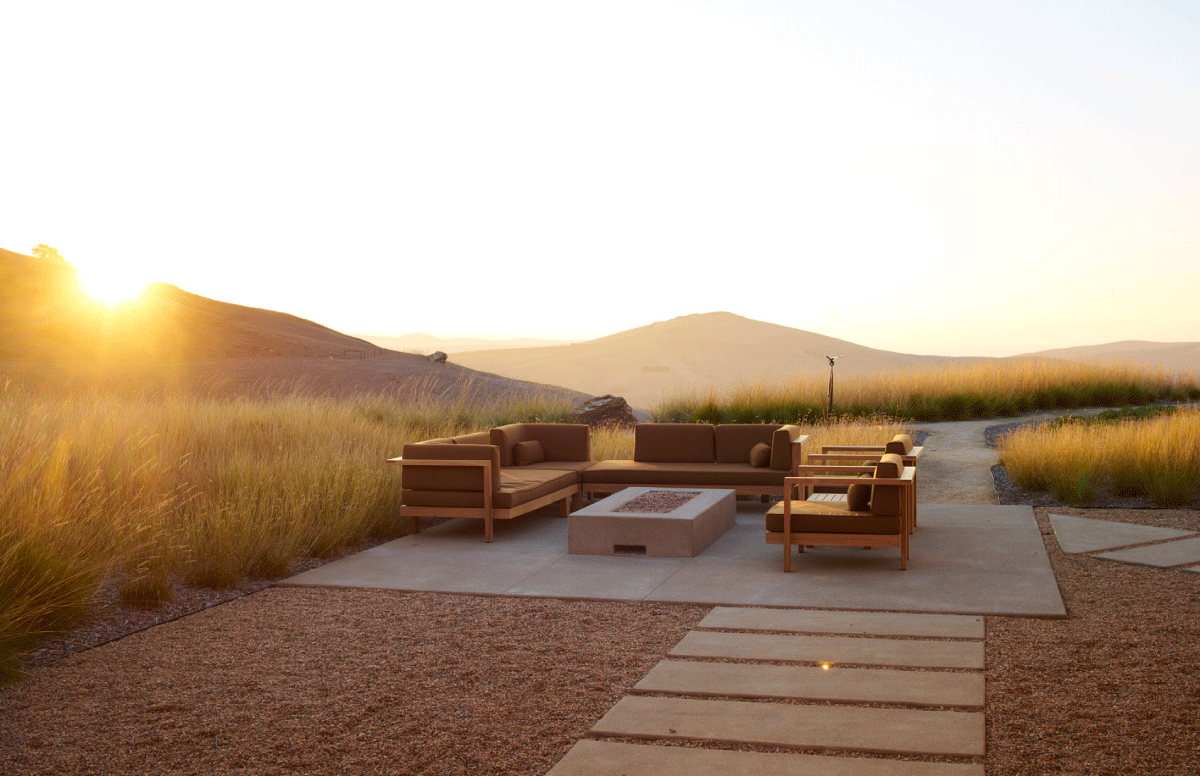
Define Design Style
A good first step is to decide whether a landscape is going to be geometric and calculated or free flowing and natural. A modern home may work better with a straight-lined landscape, but these forms can deconstruct as they move away from the structure. A natural setting such as a woodland can work well with curves and natural pathways especially if preserving existing trees.
People who like control, simple bold design, or tidy surroundings gravitate towards straight lines with geometric configurations. People who like tranquility, natural settings, or designing with nature gravitate towards flowing curves. Bold Modern style utilizes straight-line end of the spectrum and Natural Style falls on the curved line end. Mediterranean, Southwestern, Cottage, and Japanese gardens fall somewhere between. Having a clearly defined style that repeats and transitions smoothly will make a landscape feel complete.
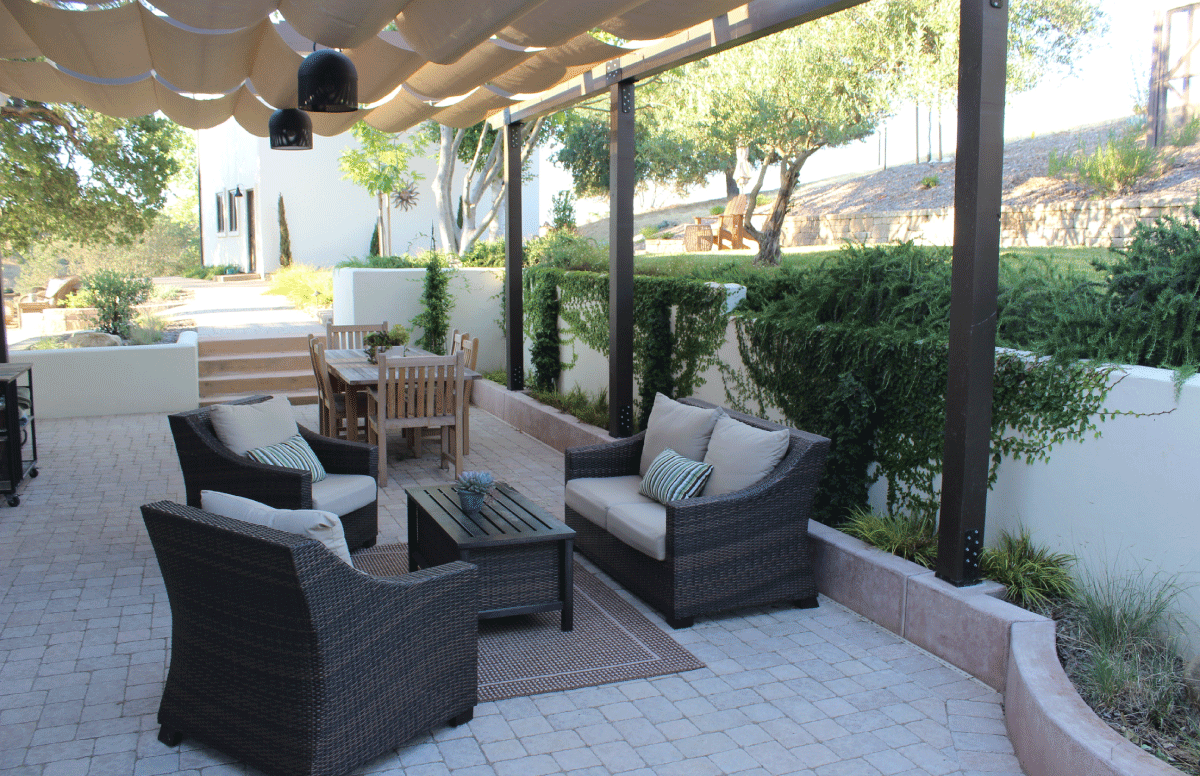
Design Spaces Before Features
While design features are important, the spaces they create are more important to the user experience. For example, a tree may be a beautiful feature, but the shade and shelter a tree grove provides can create a comfortable room complete with walls and a ceiling. Comfortable spaces are often perceived as a bit wider than they are tall, or 1 to 1.618 height to width per the golden ratio. A pergola 16 feet wide by 10 feet tall is a good example. The same comfortable feeling can be achieved with shrubs and trees.

Conversely, putting too many plants next to a front door entry can make it feel tight and uninviting. Open it up and make the path wide, prominent and inviting. Wide open views will feel more comfortable when framed with trees or from a comfortable viewing patio. The psychology of spaces can be overwhelming, but it is obvious when a space feels right.
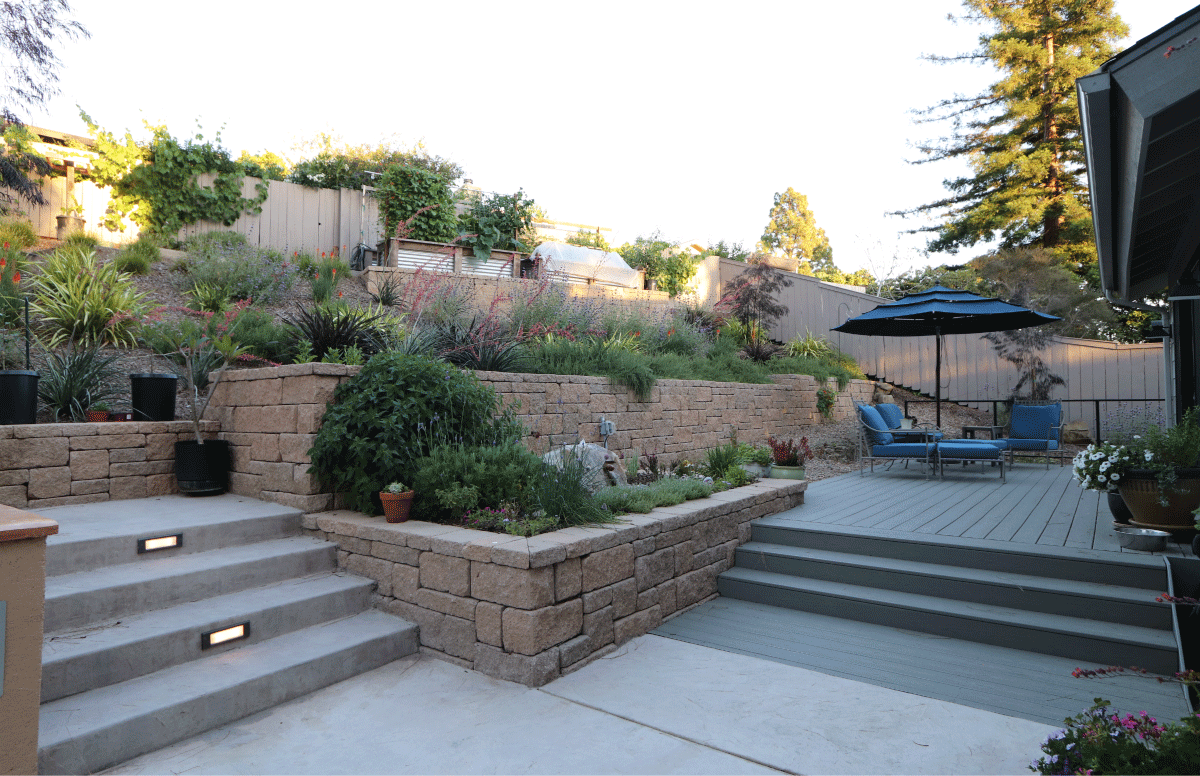
Work Out Transitions
Landscape is the glue that holds together spaces and structures. Transitions can be the most dynamic aspects of a landscape, or they can be eyesores. Complex hardscape features such as patios, retaining walls, fences, pergolas, outdoor kitchens, water features, and fire features will often intersect and connect with one another.
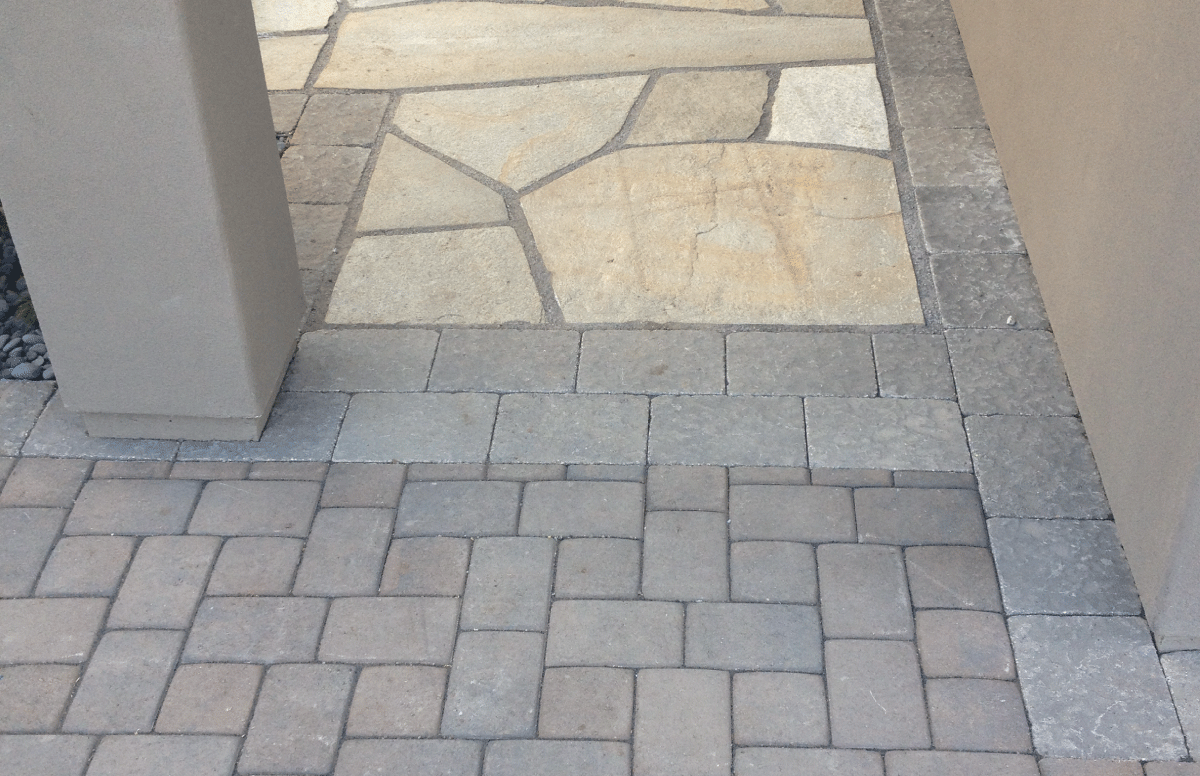
Figure out how connections will work to make a seamless transition point. Formal landscapes will often transition to a natural area. Utilize decorative bunch grasses on the edge of the landscape to blur the line between mulched landscapes and natural areas. When utilizing multiple design styles, create transitional landscapes to blend gradually. For example, a contemporary landscape may transition to a natural area going from straight lines to calculated arcs and then to a curved path.
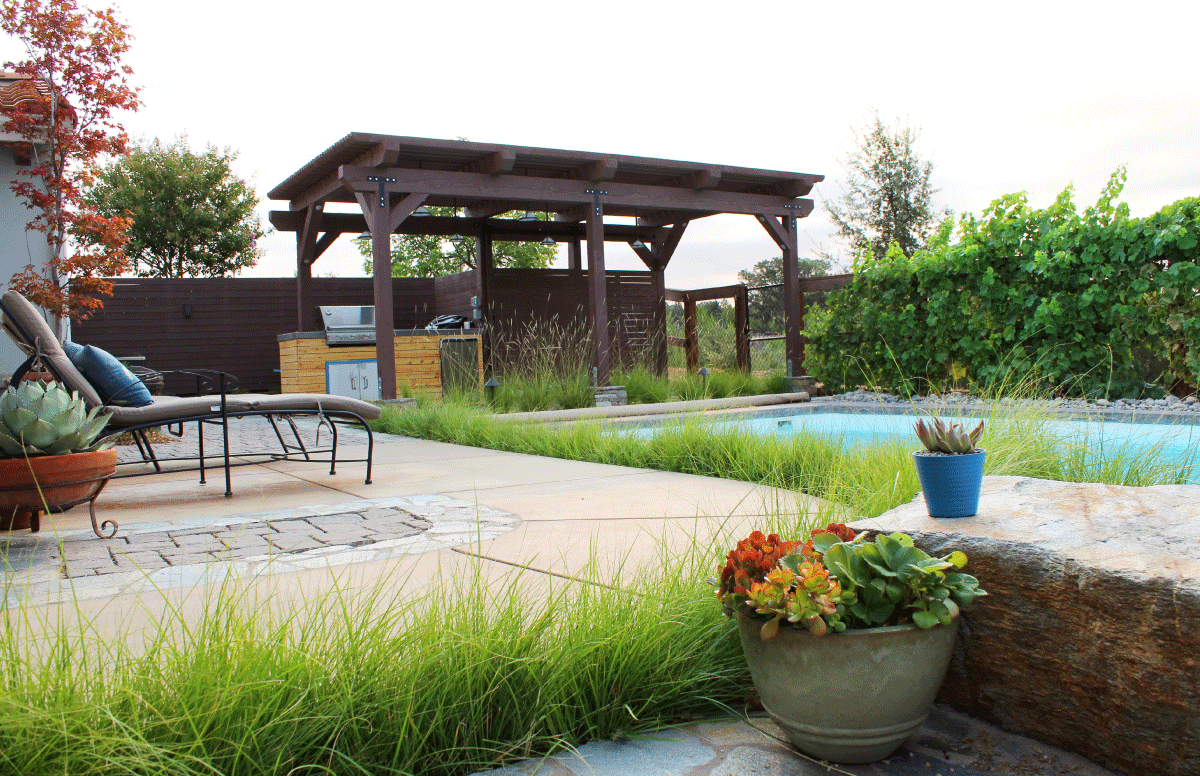
Iron Out the Details
Details in the landscape should emphasize the overall design style and theme. In most cases, color themes should be complementary, so they don’t clash. Choose colors for concrete, stone, wood, paint, mulch, and plant material that paint a picture that goes together.
Textures should also be considered. Fine texture details such as exposed aggregate concrete, small ledge stone, or small plants can feel lost in a large space. Bold coarse texture details like large boulders or big leaved plants can feel overbearing in small spaces. Perennial plants provide color, texture, and movement.
Plants should fit the design style with color as well as layout. Bold masses of plants work well with contemporary landscapes, while multi-species combinations can work well with natural areas. Finishing details can make the difference between a hodge-podge yard and a cohesive landscape.
There is a lot to think about when trying to maximize a landscape. A professional can help. Landscape designers can take ideas and dreams and turn them into a buildable design. Knowing the process before starting design or construction can be invaluable to being able to communicate goals and expectations to create a successful landscape to enjoy for years to come.
Ready for a landscape design and not sure where to start? Contact our landscape designers at [email protected] or (805) 466-6263.
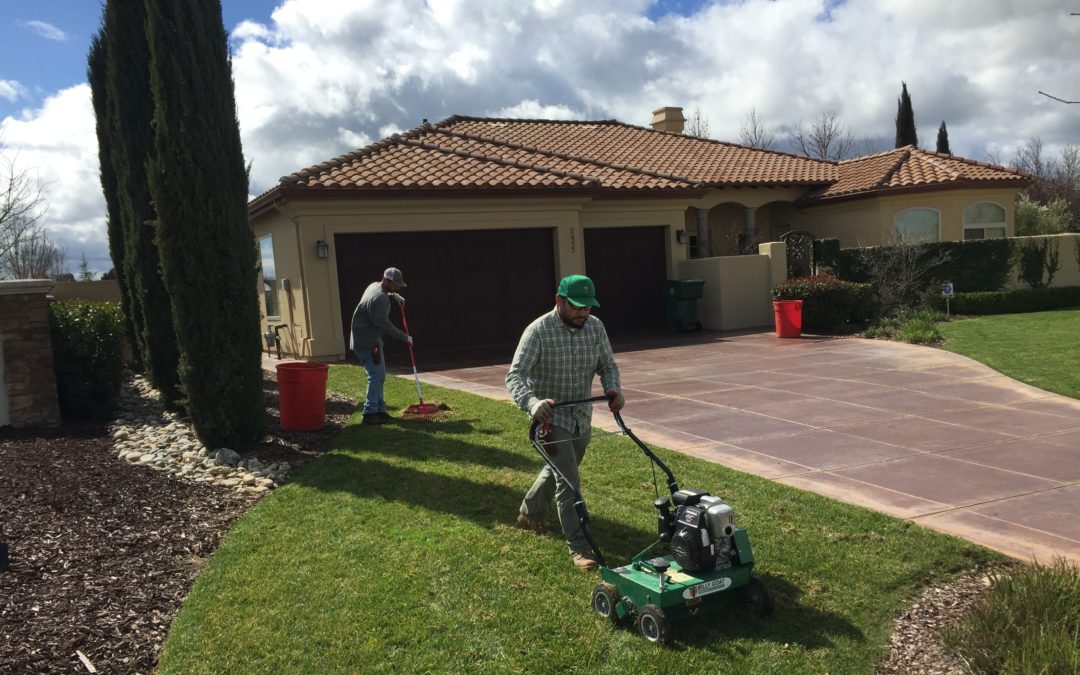
May 30, 2019
Top tips for selecting a landscape maintenance team
From weekly to seasonal maintenance, to event preparation, or landscape enhancements: here are the top questions to ask to ensure you hire a licensed professional who will meet your needs.
1. How long have you been in business?
A company that has been in business ten years or more is likely a reliable, trustworthy contractor. Whether you are a homeowner who needs weekly maintenance or a commercial property owner who needs pest control, check the company’s portfolio to see whether they have expertise on projects like yours.
Madrone Landscape has been in business for over 40 years. We offer weekly gardening services for residential clients in North San Luis Obispo County and estate maintenance for the broader San Luis Obispo County, Northern Santa Barbara County, and Southern Monterey County. We also offer high quality commercial, municipal, and HOA maintenance services for all of San Luis Obispo County.
2. What kind of insurance and licensing do you have?
Your landscaping company should have workers compensation insurance, general liability insurance, bonded workers and appropriate state licensing. For weed, pest, and disease control, your maintenance contractor will need to be spray certified.
Madrone Landscape has workers compensation insurance and general liability insurance. Our landscape maintenance crews are bonded, and we maintain a California state landscape contractor license.
3.Do you have specialists on staff?
Professional landscaping firms will employ experts with degrees in landscape architecture and horticulture. They should have expertise in landscape irrigation, as well as thorough knowledge of the type of plants you have growing in your landscape design.
At Madrone Landscape, our degreed and trained landscape designers and horticulturists establish and maintain our clients’ landscapes in superior condition. Our landscape maintenance teams are led by Taryn Via, Maintenance Manager. With a background in property management, Taryn has over 13 years of experience working directly with homeowners, HOAs, and commercial property owners.
4.What services do you offer?
Homeowners, commercial property owners, and HOAs all require different services for different properties. Ensure the company you hire provides the services you require. Traditionally, maintenance projects may include mowing and editing, irrigation repair, fertilizing, dead-heading, and mulching. Larger projects may need specialized maintenance at different intervals throughout the year. Consider whether you need seasonal maintenance, event preparation, and/or regular landscape enhancement.
5.How do your maintenance crews practice sustainability? Do you offer alternatives to chemicals?
If sustainability is important to you, be sure to ask about alternatives to fertilizer and chemicals. Companies at the forefront of landscaping will employ methods such as compost tea fertilizer, integrated pest management, and organic fertilizers, ensuring your yard is a safe and healthy place for your family.
At Madrone Landscape, we are known for sustainable practices. We focus on plant health and the effective use of water. Our Healthy Gardens program introduces organic methods to fertilizer and weed, pest, and disease control.
6. Can you provide us with an estimate?
A professional landscape contractor will provide you an estimate tailored to your individual needs. After visiting your project, listening to your needs and requirements, they will ask you questions to determine your exact needs.
Madrone Landscape provides a customized written estimate for each project.
7. What does my contract include?
Once you’ve accepted your estimate, your landscape contract will provide you a contract outlining what to expect on each visit, ranging from weekly maintenance to seasonal maintenance, plant replacement, and irrigation repairs.
At Madrone Landscape, each contract is different – just like each project. Once we’ve discussed your estimate, we put together a custom contract specifically for you.
8. How do you communicate with clients?
Will you have an account manager assigned to you? Will they call you to schedule appointments, or simply send notices in your invoice?
Our Maintenance Manager, Coner Boaen, is the one point of contact for our maintenance clients.
9. Will you provide references?
In addition to checking Yelp to see how the company ranks, ask for references, including addresses. Check the properties to see if they are maintained at the level you expect for your own property, whether residential or commercial. Madrone Landscape recently was awarded “Top-rated Local” for ranking in the top-five landscape companies in the state for customer satisfaction.
We are happy to provide a list of references for you to call and testimonials for your review!
Do you have additional questions? Ask for Coner Boaen, Maintenance Manager, at (805) 466-6263.



























